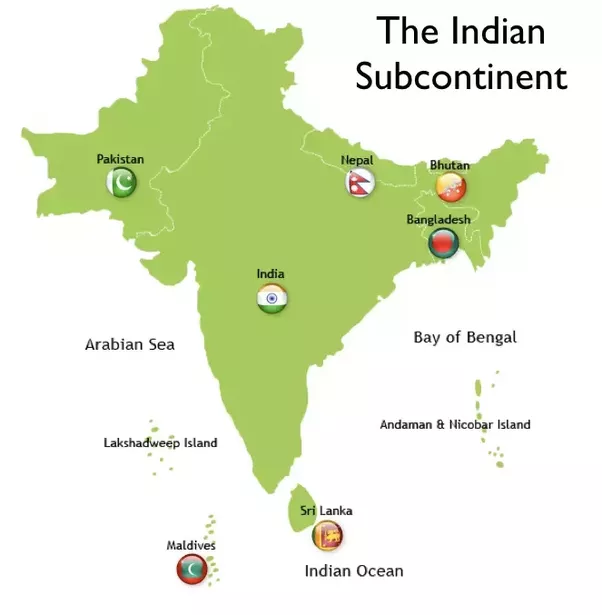The artwork of India is as diverse as its people, its countries include (see below) Pakistan, Bangladesh, Sri Lanka, India, and Nepal (Wikipedia, 2022).
The first piece I've selected is by Ismail Shammout, titled Dreams of Tomorrow, it is the final painting of a 19-piece mural collection painted from 1997-2000 (Wikiart, 2022) in Palestinian territory. Shammout uses oil-based paints and the collection is a chronological telling of the Palestinian people from exodus to reconstruction (Wikiart, 2022).In white, the focus of the painting, is a Palestinian woman's corpse, her shape mimics the map of Palestine. The pain of the people and their long struggle under occupation is shown in the left upper corner by the reaching masses. They are waiting for redemption. Peace, hope, and a people united and free are shown on the opposite (right) side of the woman. This side is brighter, flowers, birds and the playing children speak of stability and hope for the future. I appreciate the artist's use of symbolism to tell the story of the people and would like to see all 19 pieces to better understand the history of the Palestinian people. In the red edges of the woman's dress are the names of Palestinian cities and the words love, good, patience, and tomorrow (Wikiart, 2022).
Shakuntala, oil on canvas, was painted by Raja Ravi Varma in 1898 and is on display at the Sree (Shri) Chitra Art Gallery of Thiruvananthapuram, India (Wikipedia, 2022). The story of the painting is based on Hindu mythology and is from "Mahabharata", one of the major Sanskrit epics of Ancient India (Wikipedia, 2022). Featured in the painting is Shakuntala with her two female companions and a passerby in the background. Shakuntala pretends to pick a thorn from her foot whilst searching for her absent lover (WikiArt, 2022). The scene is peaceful, the featured character is surrounded by beauty and friendship, but still she longs for her love. Varma's use of earthy tones, light and shadow give this piece a realistic feeling transporting the viewer to the garden with the women.
1958, M.F. Husain, (Woman at Work) Untitled
The final piece I've selected is my favorite. Husain often used cubism, the style of painting seen above in his untitled work, oil on canvas, painted in 1958. One of the most well-known and internationally acclaimed Indian artists of the 20th century, he was known for his progressive style and was one of the pioneers of early Indian Modernism (WikiArt, 2022). I was unable to discover where this work is displayed currently. I love the choice of muted colors, the simplicity of the girl and bird, and the subject matter, a woman at work. I would proudly display this piece anywhere. I find it enduring and soothing, a gentle reminder to slow down and appreciate the small things.
The influence of religion and culture are clearly portrayed in all of these artists' work, but with great diversity of style. Shakuntala is the oldest piece and Dreams of Tomorrow, the most recent work, by a Palestinian artist. Husain makes a clear departure from the traditional painting styles of the others with his early use of cubism.
References
WikiArt. (2022). Dreams of Tomorrow. (online). Dreams of tomorrow .., 1997 - 2000 - Ismail Shammout - WikiArt.org
WikiArt. (2022). M.F. Husain. (online). M.F. Husain - 79 artworks - painting (wikiart.org)
Wikipedia. (2022). India. (online). India - Wikipedia
Wikipedia. (2022). Shakuntala. (online). Shakuntala (Raja Ravi Varma) - Wikipedia







The works that you chose were absolutely incredible! I love the symbolism behind them and that they tell a story with every stroke. I especially enjoy Shakuntala. I am not sure what draws me to it but it is beautiful. It makes me want to read the myth behind it and find out why her lover was missing. I can almost feel her struggle through the painting. Love the blog!
ReplyDeleteDreams of Tomorrow, what a powerful piece. I enjoy art that has a deep meaning behind it, and while I usually shy away from pieces showing suffering, this to me looks like more of an awakening or a big push toward peace. I especially love the spear in her hand, with the people helping to hold it upright like they are staking their claim to this joyful reformed country.
ReplyDeleteI love the colors in Shakuntala. The painting is warm, bright, and lightly blended. Its mood makes me want to be there with them, enjoying a light stroll on a beautiful day, barefoot and all.
I really enjoyed the “Dreams of Tomorrow” it reminded me of how much a small community can come together and make miracles happen. I love how all the colors are used and it's so bright. All the paintings you used were great but this one also reminds me of the Disney movie, Moana. The people worship the goddess TeFiti (an island shaped as a lady sleeping), who brought life to the ocean, using a stone as her heart and the source of her power. She was in charge of keeping her people safe and her lands filled with plenty of ways to get food. This lady in this painting looks like she does the same for hers. Dreams of Tomorrow has so much in it, you could stare at it and have your imagination going every which way. This was a wonderful choice of art; I would love a copy of this. Good job Regan!
ReplyDelete